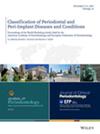Hypomethylation of the interleukin-6 promoter in gingival tissue of patients with periodontitis.
IF 3.8
2区 医学
Q1 DENTISTRY, ORAL SURGERY & MEDICINE
引用次数: 0
Abstract
BACKGROUND DNA methylation may influence cytokine expression and clinical manifestations of periodontitis. This study assessed the interleukin (IL)-6 DNA methylation in gingivae with and without clinical inflammation and its impact on clinical manifestations and cytokine expression. METHODS Sixty-two gingival biopsies (17 from controls and 45 from periodontitis sites) were analyzed. IL-6 protein concentrations were measured using an enzyme-linked immunosorbent assay, and methylation of the IL-6 promoter was analyzed by bisulfite sequencing. At 19 motifs spanning from 1200 to 27 base pairs (bp), the methylation rates for each motif and the overall promoter region were assessed. RESULTS IL-6 concentrations were significantly higher in the periodontitis group than in the control group (135.69 ± 10.24 vs. 65.17 ± 29.18 pg/mL) and were positively correlated with probing depth (PD) and clinical attachment loss (CAL) (r = 0.59 and 0.48, respectively). The overall methylation rate was significantly lower in the disease group (43.97% ± 4.54% vs. 39.54% ± 7.66%) and negatively correlated with PD, CAL, and IL-6 concentrations. Similar trends were also observed for the -74-bp motif: The methylation rate was lower in the periodontitis group than in the control group (8.9% vs. 41.2%, with a relative risk of 0.216), and gingivae with methylation at -74-bp exhibited lower PD and CALs but higher overall methylation rates. CONCLUSION DNA hypomethylation of the IL-6 promoter region, particularly the -74-bp motif, was linked to increased cytokine expression and periodontal clinical signs, suggesting its role in disease progression. PLAIN LANGUAGE SUMMARY This study examined how changes in the interleukin (IL)-6 gene-specifically through a process called DNA methylation-are linked to gum disease (periodontitis) and its symptoms. Sixty-two gum tissue samples were collected: 17 from individuals without gum disease and 45 from those with it. The gum tissues from people with periodontitis showed higher levels of the IL-6 protein, which were associated with more severe gum damage, such as deeper pockets around the teeth and greater loss of attachment. The researchers also found that a part of the IL-6 gene was less methylated in people with gum disease-a change that can lead to increased gene activity. This was especially evident at a specific site in the gene, 74 base pairs from the start. Lower methylation at this site was linked to higher IL-6 levels and more severe symptoms. Overall, the findings suggest that reduced methylation of the IL-6 gene may contribute to the progression of gum disease.牙周炎患者牙龈组织中白细胞介素-6启动子的低甲基化。
背景dna甲基化可能影响牙周炎的细胞因子表达和临床表现。本研究评估有无临床炎症的牙龈中白细胞介素(IL)-6 DNA甲基化及其对临床表现和细胞因子表达的影响。方法对62例牙龈活检进行分析,其中17例来自对照组,45例来自牙周炎部位。采用酶联免疫吸附法测定IL-6蛋白浓度,亚硫酸酯测序分析IL-6启动子的甲基化。在跨度从1200到27个碱基对(bp)的19个基序中,评估了每个基序和整个启动子区域的甲基化率。结果牙周炎组tsil -6浓度显著高于对照组(135.69±10.24 pg/mL∶65.17±29.18 pg/mL),且与探诊深度(PD)和临床附着损失(CAL)呈正相关(r分别为0.59和0.48)。总体甲基化率在疾病组显著降低(43.97%±4.54%比39.54%±7.66%),且与PD、CAL、IL-6浓度呈负相关。类似的趋势也出现在-74-bp基基上:牙周炎组的甲基化率低于对照组(8.9%对41.2%,相对风险为0.216),甲基化在-74-bp的牙龈表现出较低的PD和CALs,但总体甲基化率较高。结论IL-6启动子区域的dna低甲基化,特别是-74-bp基序,与细胞因子表达增加和牙周临床症状有关,提示其在疾病进展中的作用。摘要本研究考察了白细胞介素(IL)-6基因的变化——特别是通过DNA甲基化的过程——是如何与牙龈疾病(牙周炎)及其症状联系起来的。他们收集了62份牙龈组织样本:17份来自没有牙龈疾病的人,45份来自患有牙龈疾病的人。牙周炎患者的牙龈组织显示出更高水平的IL-6蛋白,这与更严重的牙龈损伤有关,比如牙齿周围更深的口袋和更大的附着丧失。研究人员还发现,牙龈疾病患者IL-6基因的一部分甲基化程度较低,这一变化可能导致基因活性增加。这在基因的一个特定位置尤其明显,从一开始就有74个碱基对。该位点较低的甲基化与较高的IL-6水平和更严重的症状有关。总的来说,研究结果表明,IL-6基因甲基化的降低可能有助于牙龈疾病的进展。
本文章由计算机程序翻译,如有差异,请以英文原文为准。
求助全文
约1分钟内获得全文
求助全文
来源期刊

Journal of periodontology
医学-牙科与口腔外科
CiteScore
9.10
自引率
7.00%
发文量
290
审稿时长
3-8 weeks
期刊介绍:
The Journal of Periodontology publishes articles relevant to the science and practice of periodontics and related areas.
 求助内容:
求助内容: 应助结果提醒方式:
应助结果提醒方式:


